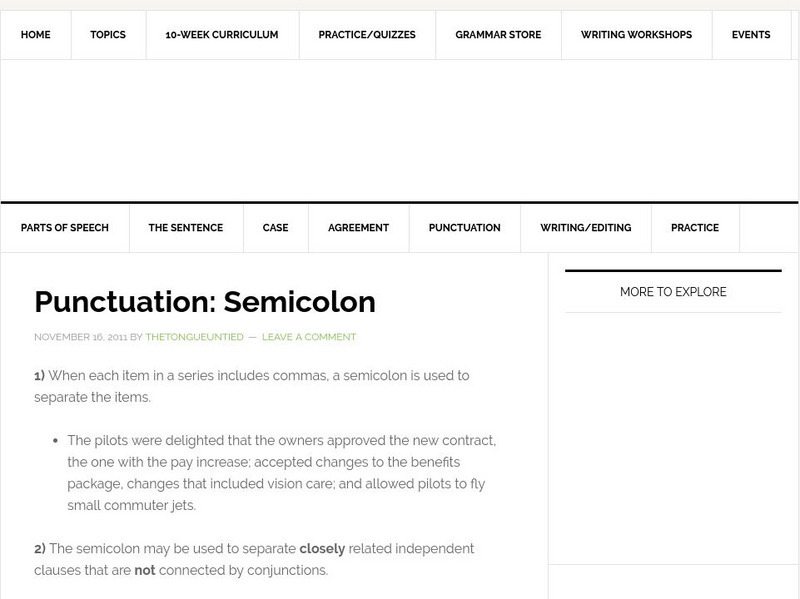Grammarly
Grammarly Blog: Each and Every
This page explains the proper use of the singular words "each" and "every" and provides examples.
Grammarly
Grammarly Blog: Comma After Introductory Clauses
Rules and examples for using commas correctly with an introductory clause.
Grammarly
Grammarly Blog: Italics and Underlining: Titles of Works
An explanation and examples using italics/underlining when writing titles.
Grammarly
Grammarly Blog: Comma in Dates
This page focuses on the use of commas when writing dates; a comma is used to separate the day from the month, and the date from the year. Examples are provided.
Grammarly
Grammarly Blog: Comma Before Parenthesis
This page explains the proper use of commas with parenthesis: no comma before a parenthesis, no comma after a parenthesis unless it is needed for another reason such as a long introductory clause in a complex sentence, and no commas if...
Grammarly
Grammarly Blog: Other Uses of Colon
Rules and examples for using colons when writing time, chapter and verse, dialogue, and business letters.
Grammarly
Grammarly Blog: Capitalization:titles of Books, Articles, Songs
This page explains the rules for capitalizing titles: In informal writing all words may be capitalized, but in formal writing, articles, conjunctions, and prepositions are NOT capitalized unless they begin a sentence. Examples are provided.
The Tongue Untied
University of Oregon the Tongue Untied: Semicolon
Discover more about semicolon usage when you visit this informative resource. Students and teachers will benefit from the examples listed for semicolon use.
Other
Seekers Blog Spot: How Setting Affects Characters
Information and examples of different ways the setting of a text can affect the characters and character development. (Published: Sept. 29, 2016)
Poetry Foundation
Poetry Foundation: Baseball Poems
A collection of descriptive and metaphorical poems about baseball, including poems by Mae Swenson, John Updike, and William Carlos Williams, and, of course, "Casey at the Bat" by Ernest Lawrence Thayer.
Other
Tinkergarten: Books That Help Us Teach Problem Solving
One of the most helpful, and easy, ways to teach problem-solving is to read, fall in love with and make sense of books that help teach problem-solving strategies. This article lists a few examples of books to use in your classroom.
The Tongue Untied
The Tongue Untied: Subordinating Conjunctions
Maintained by the University of Oregon School of Journalism and Communications, this site offers a standard definition and numerous examples of subordinating conjunctions, using journalistic (newspaper-like) examples. Provides list of...
The Tongue Untied
The Tongue Untied: Conjunctions
Maintained by the University of Oregon School of Journalism and Communications, this site offers a good definition and numerous examples of coordinating conjunctions. Also has hyperlinks to sections on subordinating conjunctions,...
Other
Medium: 35 Quotes on Design That Will Fuel Up Your Creativity
A collection of quotes on design and creativity that can inspire students and ignite discussions about what design is and how creativity goes into the design of everyday objects.
The Tongue Untied
Tongue Untied Correlative Conjunctions
Maintained by the University of Oregon School of Journalism and Communications, this site offers numerous examples of the rules of correlative conjunction usage. Also has hyperlinks to sections on subordinating conjunctions, coordinating...
Immigration and Ethnic History Society
Iehs: Bryan Winston, Contesting Immigration Incarceration
This article focuses on an example of Enrique Betancourt, a Mexican immigrant who was incarcerated for larceny and was released in an unusual manner. This case shows how both Mexican migrants and Mexican officials initiated deportations...
Grammarly
Grammarly Blog: Anymore vs. Any More
This page explains the use of "anymore" in informal writing, but in formal writing and anywhere else, "any more" is preferable. Examples are provided.
Grammarly
Grammarly Blog: Missing Comma Before a Question Tag
Rules and examples for using commas when writing a question tag at the end of a sentence.
Grammarly
Grammarly Blog: Comma Emphasizing Contrasting Ideas
This page focuses on the use of commas around contrasting ideas to emphasize that the subject has been modified; examples are provided. Signal words for contrasting ideas include not, unlike and never.
Grammarly
Grammarly Blog: Hyphen in Compound Adjective With Comparatives/superlatives
Rules and examples for creating the comparative and superlative forms of adjectives with or without hyphens.
Grammarly
Grammarly Blog: Everyone vs. Every One
This article provides the rules for the proper use of the words "everyone" and "every one" with examples.
Grammarly
Grammarly Blog: Quotation Marks in Titles
Rules and examples for using quotation marks correctly when writing titles of short works.
Grammarly
Grammarly Blog: Period
Rules and examples for using a period correctly at the end of a sentence.
Grammarly
Grammarly Blog: Exclamation Mark
This page explains the uses of exclamation marks including when to use and not use them and provides examples.






















